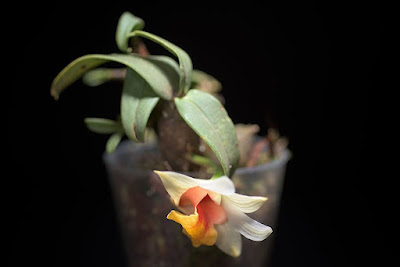Dendrobium bellatulum is native to Southeast Asia. Plants are found in north-eastern India, including Sikkim and the Khasi Hills (Khasia). They also grow on the southern Shan Plateau in eastern Burma, in northern Thailand, in the Sedone area of Laos, near Dalat in Vietnam, and in the Provinces of Yunnan and Mengtze in southwest Chia.
Dendrobium bellatulum, also called as The Enchanting Dendrobium, Dendrobium bellatulum var. cleistogamia, is a species of the genus Dendrobium. This species was described by Rolfe in 1903.
IDENTIFY DENDROBIUM BELLATULUM
Dendrobium bellatulum is native to Southeast Asia. Plants are found in north-eastern India, including Sikkim and the Khasi Hills (Khasia). They also grow on the southern Shan Plateau in eastern Burma, in northern Thailand, in the Sedone area of Laos, near Dalat in Vietnam, and in the Provinces of Yunnan and Mengtze in southwest Chia. They are found in bright forests with deciduous trees at heights of 900-1700 m, but they also were found even at an altitude of 2100 m.
It is a mini-miniature sized, warm to cold growing epiphyte, which can reach a height of 5-10 cm, with tufted, erect to suberect, close set, very short, ovoid to fusiform, gray-green, covered in fine black hairs, longitudinally rugose-costate, 2.5-8 cm long stems carrying 2 to 4, eventually deciduous, subterminal, distichous, ligulate to narrowly elliptic to oblong-lanceolate, obtuse, unequally bilobed, gray-green, 3-6 cm long, covered in fine black hairs on both surfaces, leathery leaves covered in black hairs.
The Enchanting Dendrobium blooms most often in the spring on an axillary, very short, racemose, simultaneously 3 to 5 flowered inflorescence arising on leafy stems, that have fragrant, long-lasting flowers held close to the pseudobulb. The flowers are 3.8-4.6 cm in diameter and are large in relation to the size of the whole plant. The petals of both whorls are creamy-white with green veins and glisten in the light. The lip is brightly colored, yellow at the base, with a pink or deep purple spot at the apex, side plots are cinnabaric, and the tip is bright, orange-red. The lip has 5 papillary bulges. Over time, the colors deepen. The middle plot bends sharply at the end.
DENDROBIUM BELLATULUM CARE AND CULTURE
Cultural information should only be used as a guide, and should be to be adapted to suit you. Your physical location; where you grow your plants, how much time you have to devote to their care, and many other factors, will need to be taken into account. Only then can you decide on the cultural methods that best suit you and your plants.
Light:
Dendrobium bellatulum needs a light level of 35000-40000 lux. This plant will grow well and healthily when it is grown in a crop with only slight shading.
Temperature:
It is a plant with moderate heat requirements and requiring a cold resting period. In summer, the average day temperature is 25-27 ° C, night 18-19 ° C, which gives a daily difference of 7-9 ° C. In spring, the average day temperature is 29-30 ° C, the night 11-18 ° C, with a daily amplitude of 11-18 ° C. In winter the average day temperature is 24-25 ° C, night 8-9 ° C, which gives a daily difference of 15-18 ° C.
Humidity:
The Enchanting Dendrobium needs the humidity of 75-85% for most of the year and drops to around 60% for a period of 2 months at the end of winter and at the beginning of spring.
Substrate, growing media and repotting:
Dendrobium bellatulumare best mounted on tree fern washers. If they must be grown in pots, it is recommended to use finely chopped tree fern fibers, but any loose, quickly draining substrate can be used, as long as it fits very thin roots. This species should be planted in possibly small pots, so that the roots dry quickly between waterings. Therefore, cultivation on rootstocks is preferred, but in this case, the plants must be watered at least once a day during the summer.
Increments are very densely grouped and repotting is rarely necessary before the substrate is unfolded. After repotting, plants can go back in growth and often require a long time to return to their normal condition.
Watering:
From spring to early autumn, when there is a period of active plant growth, water is abundant. The substrate of the plants in cultivation should be moist, and between each watering should only slightly dry out. When new growths reach maturity in the autumn, the amount of water should be gradually reduced.
Fertilizer:
Dendrobium bellatulum should be fertilized every week 1/4-1/2 of the recommended dose of fertilizer for orchids. A fertilizer with a high nitrogen content is beneficial from spring to mid-summer, and a fertilizer richer in phosphorus should be used in late summer and autumn.
Rest period:
For 3 winter months, temperatures fall below 10 ° C at night. Dendrobium bellatulum are able to tolerate even a few degrees below zero for a short time, but cultivation should avoid such extreme situations. During very cold weather, the chance of surviving the plant and not experiencing damage is higher when the plant is dry. The plants should be allowed to dry before the next watering, but it must not be allowed to that they stay dry for a long period of time. Whenever the amount of water decreases, the fertilization must also be reduced or eliminated.















COMMENTS